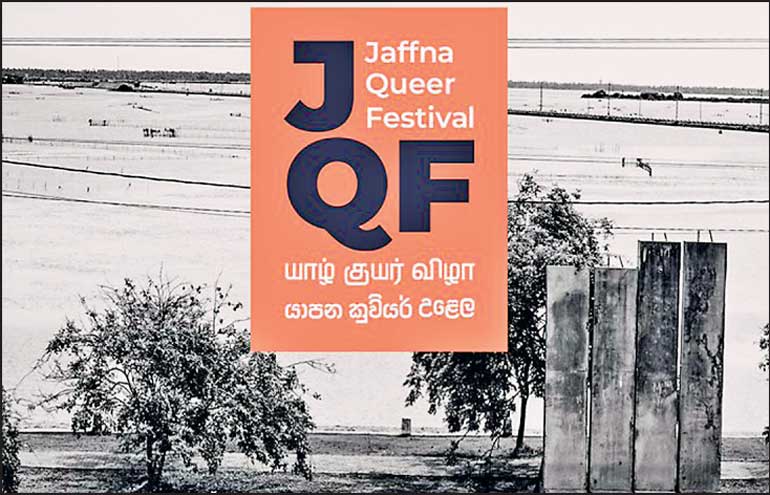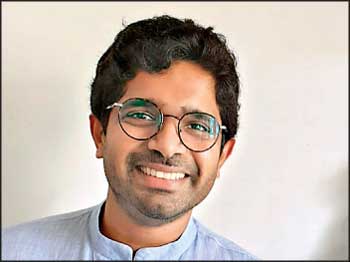Friday Jan 31, 2025
Friday Jan 31, 2025
Saturday, 18 December 2021 00:00 - - {{hitsCtrl.values.hits}}

The Jaffna Queer Festival ran from 21-30 November
 By Iraj De Alwis
By Iraj De Alwis
I was walking down a small road in Kayts that ran along the seashore when I noticed a strange flower: light purple blooms waved all along the edge of the water peering out of a thick flat underbrush. It looked like the kankun flower or its close relative the morning glory that you find growing in people’s gardens. But how can a morning glory grow by the sea amidst all the salt?
I was puzzled so I knelt down and got close to it. This trumpet shaped flower looked exactly like a morning-glory and, like its doppelgänger, it grew out of vines that had criss-crossed to form a carpet like layer. But the leaf of a normal morning glory is thin, somewhat large and is usually heart-shaped or has three-slightly separate lobes, while the leaf I was ogling was thick, fleshy, small and oval shaped.
I was lost in my observations, amazed at how similar flowers seemed to spring from such different plants, when I was startled to find that I was being observed. A young man, around the same age as my students, was staring at me from his guard post at the top of a tower. His arm was resting on his rifle and he smiled uncomfortably. I smiled back equally uncomfortably and walked on.
After a little research I found out that the flower was Ipomoea pes-caprae also known as the beach morning glory. It is a cousin of the common morning glory, but only grows at the edge of the land and the sea. It is a widely-dispersed, salt-resistant plant, indigenous to most coastal regions of the world. It protects coastal dunes from erosion.
I did not know this then, but I know this now.
Jaffna Queer Festival
The Jaffna Queer Festival ran from 21-30 November and consisted of a variety of online events including films and talks by Leena Manimekalai, Swarnavel Eswaran, Lenin M. Sivam, Sumathy Sivamohan and Visakesa Chandrasekaram; lectures and readings by Isuru Chamara Somaveera, YaliniDream, Nadika, Shoba Sakthi and Wara Thiagarajah; and poetry and performance art by members of the community including Kannan Sudarshan and the host of the festival, Kastro Ponnathurai. If you are interested in diving deeper and learning more, the work of these artists and scholars is a great place to start.
For those who are not so familiar with thinking about LGBTQ experiences, I want to share some reflections on queerness inspired by the work of the visual artists Kajendran Sivasubramaniyam and Krishnapriya Thabendran featured in the festival.
Sivasubramaniyam’s photographs
Sivasubramaniyam exhibited a series of photographs set by the seashore depicting a queer couple and a couple of Delft ponies. A few show the couple together dressed in wedding garb, a few were solo portraits and in a few a couple of delft ponies shared the frame with people.
I was struck by how the couple was dressed in traditional heterosexual symbols – blue suit and a red sari. A familiar sight, but in a new and strange setting. The figure in the suit, a performance artist from Jaffna, stood at the centre of the frame, a solid heavy figure who looked at the camera with a deep smile. This was not a fleeting and erasable presence, but one that stood firmly rooted in the soil. The companion had a similar glorious air, expanding to fill the frame in that red sari as it caught the wind. They were confidently and proudly saying- this is us and we are from here.
Every shot was composed to show both land and sea. It emphasised the edge, that liminal marginalised space that queer people occupy in our society. This coastal setting reminded me of a film set in Taiwan, where the queer protagonists flee their homes on a train to get as far away as possible only to arrive at the sea and realise that they are stuck on an island. They have to go back and make a life and home in this place they cannot leave. The two figures in the photographs showed no intention of leaving. They seemed to have sprung from the ground in that strip of land along the coast. They were flowers of Jaffna who were celebrating their strength and resilience, their ability to have survived and have made a life in the peninsula.
In one image, they held up the regular rainbow flag. In the adjacent image, they waved a long triangular flag with the rainbow colours reworked into a new order with the addition of an extra-colour: dark blue. Holding these flags, they were claiming this space as their own.
The artist said he had altered the traditional western rainbow flag to symbolise how queer culture, most of which originates abroad, has been reworked, domesticated and made indigenous by the queer community of the island.
I asked him about the ponies. “Those are Delft ponies,” he replied, “They are a mix of local and foreign animals, but born and raised here. Some people think they are a cross between donkeys and horses. Others think they are small horses. People have different stories about them but everyone associates them with Jaffna.” The similarity seemed clear: people have all types of unclear notions about the queer community, about whether they are foreign or indigenous, normal or abnormal. And yet they, like the ponies, are undeniably flowers of this land.
I did not know this then, but I know this now.
Work of Krishnapriya Thabendran
The work of Krishnapriya Thabendran is abstract and so is harder to write about. Her exhibit focused on cells. They were parchment coloured drawings of rows and rows of tiny cells each dotted with a nucleus. Some of these cellular masses looked like familiar shapes: an eye, a closed pomegranate, an hour-glass and so on. The centre of the exhibit was a short video where these drawings shifted and morphed in and out of each other to a pained and discomforting soundtrack. I didn’t speak to the artist so I can only really write about how I felt watching these cellular images twist and dance across the screen.
I sat for a while and listened to the soundtrack. I don’t speak Tamil well enough to understand what she said. But in her tone of voice and in the plaint of the accompanying violin I recognised pain. The rows and rows of cells twisting and folding made me think of pain. In the rhythm of her speech, heavy and repetitive like a deep drum, I heard pain. It was pain that was deep in bone and muscle, in the mind and in the soul. As I sat on the floor and watched, I was absorbed in a world of ever-present pain.
It made me think of how the experience of being marginalised due to sexuality, gender, ethnicity, faith, caste or colour comes down to this physical pain. It’s a pain that sits deep inside of you, in the very cells of your body. You spend your entire life with that pain. There is almost never a day when you don’t feel it. Even if you have managed to create a stable life, almost every day you have a moment (often several) when something happens, like a mindless comment, a hateful act, a glaring look or the absence of recognition, that throws you back from your normal day into the margins of life. I thought about how it is to live with that pain deeply embedded in your cells.
But I could not shake off this feeling that the pain depicted was both so much more universal and common, and yet also particular to the artist. The video kept shifting. The cells bent and folded and twisted in lurid ways. The violin notes were chilling. Images of an eye, an elaborate earring, and flowers cut through the sequence of dancing cells. The artist had created a hypnotic experience that evoked the everyday pains of illness and work, loneliness, alienation, and regret that we all feel. In the world of this video, pain seemed to me the fundamental building block of all life.
I wondered what personal pains of Thabendran I was witnessing. Was I seeing the pain of someone exiled to the margins of the world? The pain of someone who had survived the armed conflict? The pain of someone who had lost love, or a life that could have been? There were no answers, but I could not shake off the feeling that I was sharing in some particular history of suffering.
The cells formed many shapes. Three of these shapes sent me on reveries.
The cells twisted into an hourglass that made me think of how pain is ever present and how time can heal this pain, or it cannot.
The cells traced the shape of an eye that made me think of our ability to witness pain in ourselves and in others. Recognising pain, never turning away, but gently observing can help us heal, grow and empathise. Or it can help us to make peace with what cannot be healed. Or it can make us go mad.
The cells arranged into a flower in bloom made me think of the beauty that is still possible in bodies and in lives marked by pain. Flowers kept occurring over and over again in the video: botanical sketches and photographs of fields of wildflowers. They filled the screen contrasting with the brownish rows and rows of squares. I was filled with a sense of hope. Not a naive and loud hope, but a quiet resilient one. The hope of the wildflowers that keep growing from the land relentlessly. I was overcome with a belief in life and growth.
Thabendran took me on a journey deeper into myself and my own suffering, and from there into the suffering of others, both queer and not. Kajendran gave me icons of strength who bloomed in this land. In fact he introduced me to one of his models, Anton Udayakumaran, a drag performer. “Seek God and everything will seek you” were the wisdoms he gifted me to take back from this journey.
I did not know these things then, but I know them now.
(Iraj De Alwis teaches history and literature. He has completed an MA in literature from Harvard University and a BA in history from Middlebury College, Vermont.)